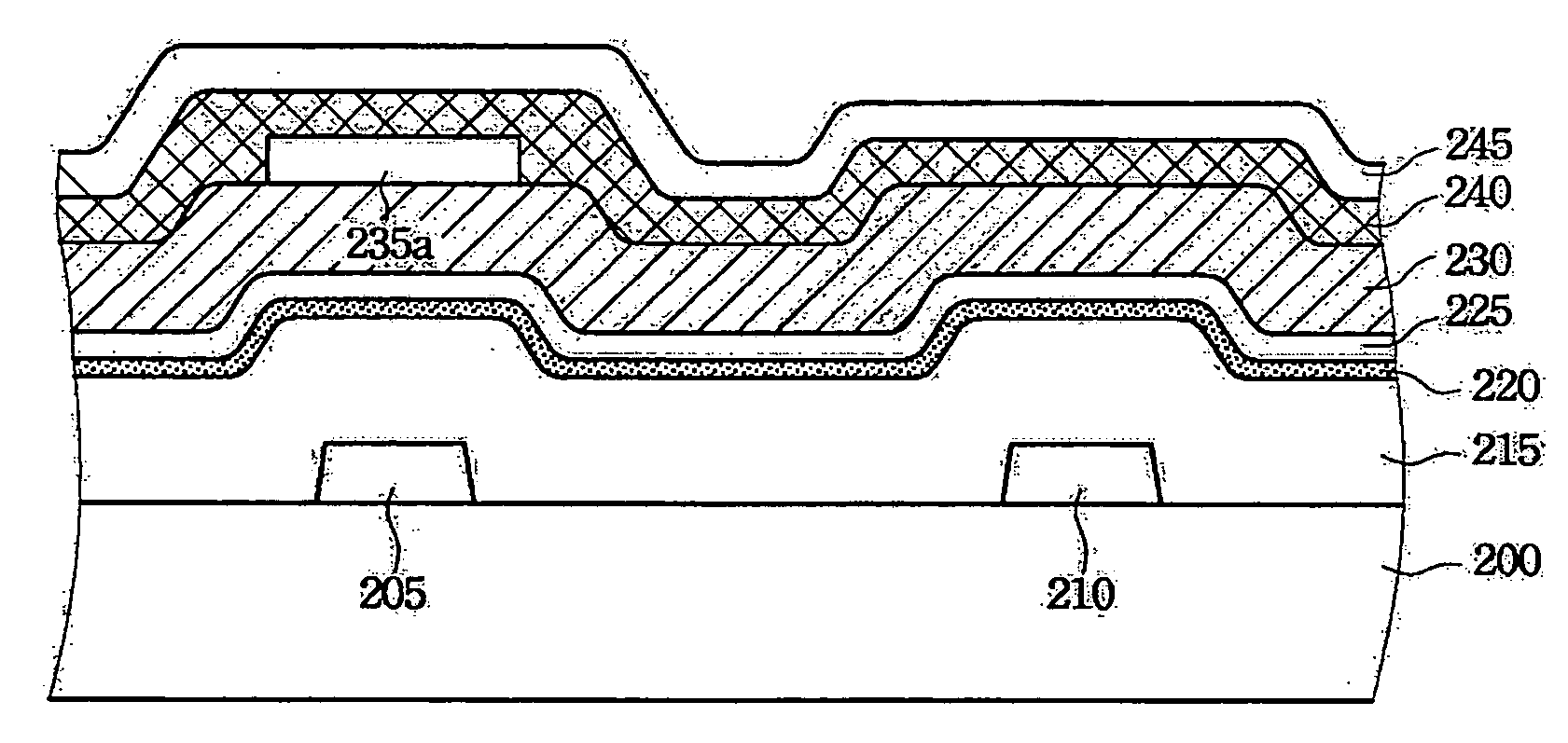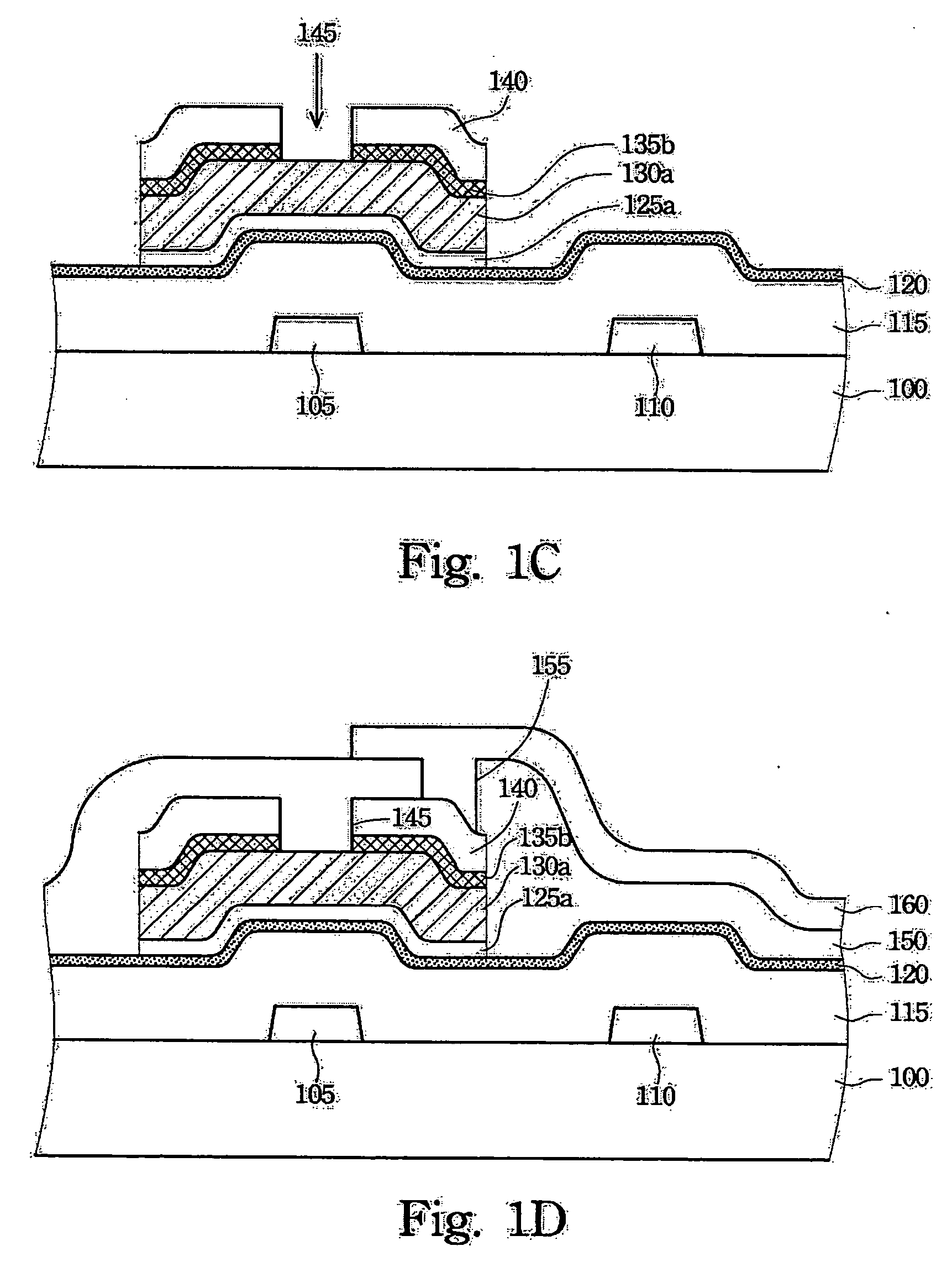Method of controlling a capacitance of a thin film transistor liquid crystal display (TFT-LCD) storage capacitor
a technology of liquid crystal display and storage capacitor, which is applied in the direction of instruments, semiconductor devices, optics, etc., can solve the problems of inability to design tft dimensions according, affecting the thickness uniformity of the storage capacitor dielectric layer in each pixel, and poor thickness uniformity of the gate dielectric layer after over-etching on the entire transparent substrate. achieve uniform thickness, improve display quality, and increase the aperture ratio of each pixel
- Summary
- Abstract
- Description
- Claims
- Application Information
AI Technical Summary
Benefits of technology
Problems solved by technology
Method used
Image
Examples
embodiment 1
[0024]FIGS. 1A-1D are schematic, cross-sectional views showing a process for controlling the capacitance of the TFT-LCD storage capacitor according to a first preferred embodiment of this invention. In FIG. 1A, a first conductive layer is formed on a transparent substrate 100 and then is patterned to form a gate 105 and a bottom electrode 110 respectively on the transparent substrate 100. Then, a first silicon nitride layer 115, a dielectric layer 120, a second silicon nitride layer 125, an undoped amorphous silicon layer 130, and a doped amorphous silicon layer 135 are sequentially formed on the transparent substrate.
[0025] The material of the first conductive layer is, for example, copper, aluminum. chromium or alloy of molybdenum and tungsten, and the first conductive layer can be formed by a physical vapor deposition process such as sputtering. The first silicon nitride layer 115 and the second silicon nitride layer 125 can be formed by chemical vapor deposition; the preferable...
embodiment 2
[0029]FIGS. 2A-2C are schematic, cross-sectional views showing a process for controlling the capacitance of the TFT-LCD storage capacitor according to a second preferred embodiment of this invention. In FIG. 2A, a first conductive layer is formed on a transparent substrate 200 and then is patterned to form a gate 205 and a bottom electrode 210 on the transparent substrate 200. A first silicon nitride layer 215, a dielectric layer 220, a second silicon nitride layer 225, an undoped amorphous silicon layer 230, and an etching stop layer 235 are sequentially formed on the transparent substrate 200.
[0030] The material of the first conductive layer is, for example, copper, aluminum, chromium or alloy of molybdenum and tungsten, and the first conductive layer is formed by a physical vapor deposition process such as sputtering. The first silicon nitride layer 215 and the second silicon nitride layer 225 is formed by chemical vapor deposition; the preferable thicknesses of the first silico...
embodiment 3
[0033]FIGS. 3A-3C are schematic, cross-sectional views showing a process of controlling the capacitance of the TFT-LCD storage capacitor according to a third preferred embodiment of this invention. In FIG. 3A, an undoped amorphous silicon layer is formed on a transparent substrate 300 and then is patterned to form a silicon island 305 and a bottom electrode 310 on the transparent substrate 300. A first silicon nitride layer 315, a dielectric layer 320, a second silicon nitride layer 325, and a first conductive layer 330 are sequentially formed on the transparent substrate 300.
[0034] The first silicon nitride layer 315 and the second silicon nitride layer 325 is formed by chemical vapor deposition; the preferable thicknesses of the first silicon nitride layer 315 and the second silicon nitride layer 325 are respectively about 1500-3500 Å and about 200-800 Å, and their more preferable thicknesses are respectively about 2000-3000 Å and about 400-600 Å. An etching selectivity ratio of ...
PUM
| Property | Measurement | Unit |
|---|---|---|
| dielectric constant | aaaaa | aaaaa |
| transparent | aaaaa | aaaaa |
| capacitance | aaaaa | aaaaa |
Abstract
Description
Claims
Application Information
 Login to View More
Login to View More - R&D
- Intellectual Property
- Life Sciences
- Materials
- Tech Scout
- Unparalleled Data Quality
- Higher Quality Content
- 60% Fewer Hallucinations
Browse by: Latest US Patents, China's latest patents, Technical Efficacy Thesaurus, Application Domain, Technology Topic, Popular Technical Reports.
© 2025 PatSnap. All rights reserved.Legal|Privacy policy|Modern Slavery Act Transparency Statement|Sitemap|About US| Contact US: help@patsnap.com



